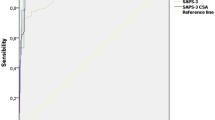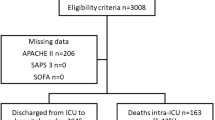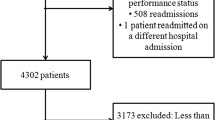Abstract
Objective
To evaluate the effectiveness of a specific oncologic scoring system—the ICU Cancer Mortality model (ICM)—in predicting hospital mortality in comparison to two general severity scores—the Acute Physiology and Chronic Health Evaluation (APACHE II) and the Simplified Acute Physiology Score (SAPS II).
Patients and methods
All 247 patients admitted for a medical acute complication over an 18-month period in an oncological medical intensive care unit were prospectively registered. Their data, including type of complication, vital status at discharge and cancer characteristics as well as other variables necessary to calculate the three scoring systems were retrospectively assessed.
Results
Observed in-hospital mortality was 34%. The predicted in-hospital mortality rate for APACHE II was 32%; SAPS II, 24%; and ICM, 28%. The goodness of fit was inadequate except for the ICM score. Comparison of the area under the ROC curves revealed a better fit for ICM (area 0.79). The maximum correct classification rate was 72% for APACHE II, 74% for SAPS II and 77% for ICM. APACHE II and SAPS II were better at predicting outcome for survivors to hospital discharge, although ICM was better for non-survivors. Two variables were independently predicting the risk of death during hospitalisation: ICM (OR=2.31) and SAPS II (OR=1.05).
Conclusions
Gravity scores were the single independent predictors for hospital mortality, and ICM was equivalent to APACHE II and SAPS II.

Similar content being viewed by others
References
Anonymous (1994) Second European Consensus Conference in Intensive Care: Predictory outcome in ICU patients. Réanimation-Urgences 3:141–234.
Abbott RR, Setter M, Chan S, and Choi K (1991) APACHE II: Prediction of outcome of 451 ICU oncology admissions in a community hospital. Ann Oncol 2:571–574
Azoulay E, Moreau D, Alberti C, Leleu G, Adrie C, Barboteu M, Cottu P, Levy V, Le Gall J, Schlemmer B (2000) Predictors of short-term mortality in critically ill patients with solid malignancies. Intensive Care Med, 26:1817–1823
Blot F , Guignet M , Nitenberg G, Leclercq B, Gachot B, Escudier B(1997) Prognostic factors for neutropenic patients in an intensive care unit: respective roles of underlying malignancies and acute organ failures. Eur J Cancer 33:1031–1037
Boussat S, El’rini T, Dubiez A, Depierre A, Barale F, Capellier G (2000) Predictive factors of death in primary lung cancer patients on admission to the intensive care unit. Intensive Care Med 26:1811–1816
Brown M, Crede W (1995) Predictive ability of acute phisiology and chronic health evaluation II scoring applied to human immunodeficiency virus-positive patients. Crit care Med 23:848–853
Brunet F, Lanore JJ, Dhainaut JF, Dreyfus F, Vaxelaire JF, Nouira S, Giraud T, Armaganidis A, Monsallier JF (1990) Is intensive care justified for patients with haematological malignancies? Intensive Care Med 16:291–297
Chu D (1993) Predicting survival in AIDS patients with respiratory failure. Application of the APACHE II scoring system. Crit Care Clin 9:89–105
Giangiuliani G, Gui D, Bonatti P, Tozzi P, Caracciolo F (1990) APACHE II in surgical lung carcinoma patients. Chest 98:627–630
Groeger J, Lemeshow S, Price K, Nierman D, White P, Klar J, Granovsky S, Horak D, Kish S (1998) Multicenter outcome study of cancer patients admitted to the intensive care unit: a probability of mortality model. J Clin Oncol 16:761–770
Haines IE, Zalcberg J, Buchanan JD (1990) Not for resuscitation orders in cancer patients-principles of decision making. Med J Aust 153:225–229
Hanley JA, McNeil BJ (1982) The meaning and use of the area under a Receiver Operating Characteristic (ROC) curve. Radiology 143:29–36
Headley J, Theriault R , Smith T (1992) Independent validation of APACHE II severity of illness score for predicting mortality in patients with breast cancer admitted to the intensive care unit. Cancer 70:497–503
Hosmer DW, Lemeshow S (1989) Applied logistic regression. Wiley, New York
Knaus W , Draper E , Wagner D, Zimmerman J (1985) APACHE II: A severity of disease classification system. Crit care Med 13:818–829
Le Gall J, Lemeshow S, Saulnier F (1993) A new Simplified Acute Physiology Score (SAPS II) based on a European/North American multicenter study. JAMA 270:2957–2963
Lemeshow S, Hosmer DW (1982) A review of goodness of fit statistics for use in the development of logistic regression models. Am J Epidemiol 115:92–106
Lemeshow S, Teres D, Klar J, Avrunin J, Gehlbach S, Rapoport J (1993) Mortality Probability Models (MPM II) based on an international cohort of intensive care unit patients. JAMA 270:2478–2486
Pierpont G, Parenti C (1999) Physician risk assessment and APACHE scores in cardiac care units. Clin Cardiol 22:366–368
Pittet D, Thievent B, Wenzel R, Li N, Gurman G, Suter P (1993) Importance of pre-existing co-morbidities for prognosis of septicemia in critically ill patients. Intensive Care Med 19:265–272
Sculier J, Paesmans M, Markiewicz E, Berghmans T (2000) Scoring systems in cancer patients admitted for an acute complication in a medical intensive care unit. Crit care Med 28:2786–2792
Smith R, Levine S, Lewis M (1989) Prognosis of patients with AIDS requiring intensive care. Chest 96:857–861
Staudinger T, Stoiser B, Müllner M, Locker GJ, Laczika K, Knapp S, Burgmann H, Wilfing A, Kofler J, Thalhammer F, Frass M (2000) Outcome and prognostic factors in critically ill cancer patients admitted to the intensive care unit. Crit Care Med 28:1322–1328
Author information
Authors and Affiliations
Corresponding author
Rights and permissions
About this article
Cite this article
Berghmans, T., Paesmans, M. & Sculier, J.P. Is a specific oncological scoring system better at predicting the prognosis of cancer patients admitted for an acute medical complication in an intensive care unit than general gravity scores?. Support Care Cancer 12, 234–239 (2004). https://doi.org/10.1007/s00520-003-0580-3
Received:
Accepted:
Published:
Issue Date:
DOI: https://doi.org/10.1007/s00520-003-0580-3




